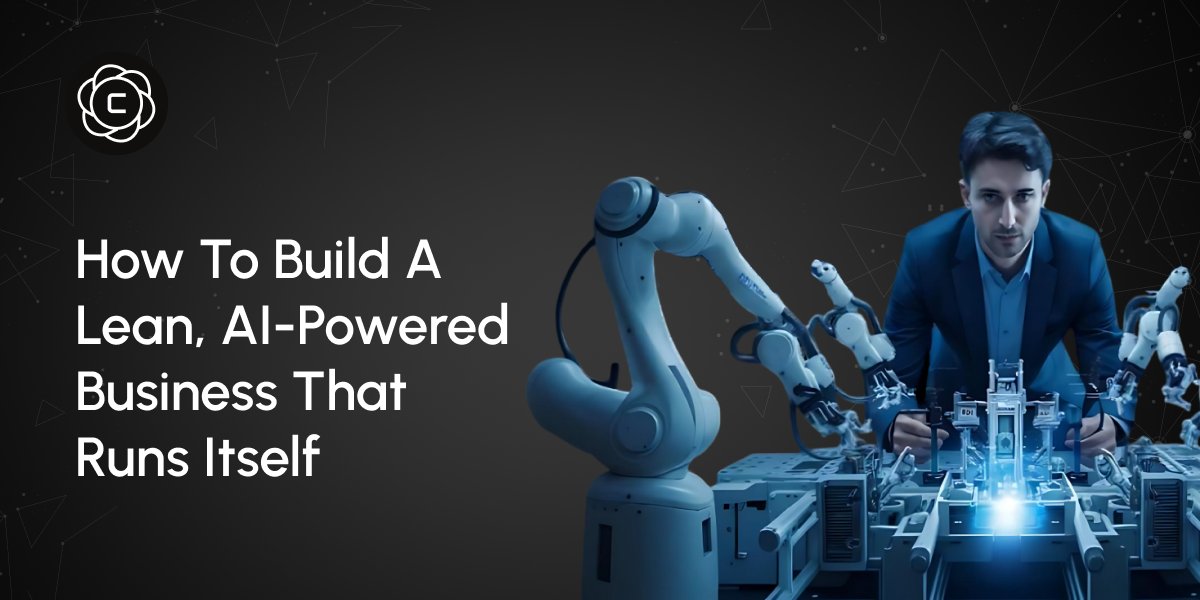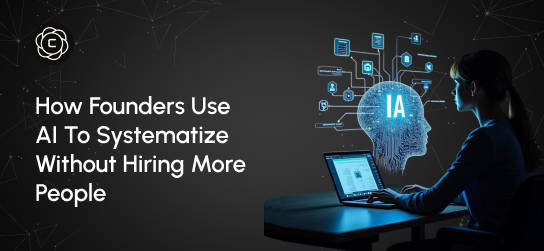LearningCenter
Master AI creativity with our comprehensive guides, tutorials, and expert insights. From beginner basics to advanced techniques.
How to Build a Lean, AI-Powered Business That Runs Itself

Introduction
Two weeks ago, I met a founder who brought in $180,000 last quarter with no full-time employees. Her business operates through a deliberately structured network of AI systems, managing acquisition, fulfillment, and daily operations with minimal human input. Her role? About four hours a day, focused entirely on strategy and business development.
This isn’t a Silicon Valley fantasy or a futurist prototype. It’s a working model of lean operations built on intelligent automation. These founders aren’t building with code. They’re designing systems that think, act, and learn with just enough human oversight to steer the ship.
For the first time in business history, execution can scale without scaling human oversight. But the leverage lies in how well you architect the system.
The Architecture of Self-Running Operations
Most traditional businesses depend on human action—someone eventually needs to decide, approve, or execute. That dependency is the bottleneck.
AI-first businesses flip the model: systems handle decision-making. Humans step in only for exceptions, escalations, or directional shifts.
The result is an operational structure where the default is autonomous flow, not manual intervention.
Decision Automation vs. Task Automation
Many teams start with task automation; email generation, data entry, post scheduling. Helpful, but limited. Self-running businesses prioritize decision automation. They build frameworks that allow systems to evaluate inputs, make decisions, and trigger actions.
Instead of auto-replying to a support ticket, the system decides which reply to send, when to escalate, and how to prioritize based on context. That shift, from doing to deciding is where scale begins.
Exception-Based Management
Once decision layers are in place, human attention shifts from daily operations to edge-case judgment. Rather than managing the whole workflow, you’re managing the 5% that doesn’t fit the pattern. It’s not hands-off. It’s high-leverage hands-on—only when needed.
Systematic Revenue Generation
Revenue no longer comes from repeated human actions. It flows from interlinked systems:
- Acquisition loops
- Conversion workflows
- Delivery engines
- Retention sequences
These systems don’t need you to push them daily. They run. You review. You optimize.
Building Your Foundation Systems
Customer Acquisition Engine
Start here. Identify your highest-leverage channels and systematize them.
Instead of posting manually, build a content engine powered by AI—blog posts, emails, social content—all running on a set schedule with predefined audience parameters.
Crompt’s Social Media Post Generator eliminates daily content bottlenecks, keeping your publishing consistent so you can focus on strategy, not scripting.
Lead Qualification and Conversion
No more manual sorting. Build qualification flows. Let AI handle standard lead types through nurture sequences, segmentation logic, and scripted conversion paths. Only the high-complexity or high-value leads get routed to you or your team. It’s not just automation. It’s smart escalation.
Service Delivery Automation
If your business delivers services, this is your next layer. AI can manage updates, deliverables, status checks, and even creative generation, automating the routine while surfacing exceptions for manual review. You maintain quality without being buried in every project.
Customer Retention and Expansion
Retention systems can now operate proactively. Monitor usage patterns. Trigger support sequences. Run upsell logic based on value metrics, not guesswork. All without waiting for a churn alert or a quarterly review.
Revenue Model Optimization
Recurring Revenue Architecture
System-led businesses thrive on recurring models. Predictable cash flow supports structured operations and reduces the need for constant acquisition effort. One-time sales often demand too much manual energy; before, during, and after the transaction.
Subscriptions, memberships, SaaS offerings, and retainers create financial stability that aligns with autonomous delivery systems.
Scalable Delivery Mechanisms
Delivery needs to scale without scaling people. That means digital products, AI-led services, or consultation workflows that run through pre-defined systems.
Even physical products can qualify as long as fulfillment, communication, and support are fully automated through reliable systems. But service businesses tend to unlock the most leverage through intelligent, self-running models.
Pricing for Automation
Pricing isn’t just about market value, it’s about operational design. With AI driving fulfillment, variable costs drop. That opens space for margins that grow with volume, not complexity.
Your pricing model should reflect not just value to the customer but efficiency behind the scenes.
Operational System Design
Customer Communication Flows
Most customer conversations follow repeatable patterns, making them ideal for automation. Welcome emails, support replies, billing updates, and service notifications can all run through structured flows. Complex cases escalate by design.
Crompt’s Email Assistant supports this model: maintaining tone, clarity, and professionalism, so founders can prioritize high-value client relationships where nuance matters most.
Quality Control Mechanisms
Self-operating systems need built-in safeguards that don’t rely on manual oversight. Automated testing, real-time feedback loops, and issue detection protocols keep performance aligned with expectations. When something breaks pattern, it’s flagged for human review—before it becomes a customer-facing issue.
Financial Management and Reporting
Routine financial processes can run on autopilot without sacrificing accuracy. Invoicing, payment flows, expense categorization, and baseline reporting are all well within AI’s capacity.
Crompt’s Business Report Generator brings it together—translating live data into insight-ready dashboards that support smart, timely decisions.
Inventory and Resource Management
Whether you manage digital licenses or physical products, resource control can be systematized. AI monitors usage, predicts demand, and adjusts reordering thresholds based on rules you define once. Instead of reactive supply issues, you get proactive resource orchestration across your business.
Managing the Human Element
Strategic Oversight Responsibilities
In self-operating businesses, human input shifts toward strategy, system refinement, and oversight—not day-to-day execution.
Your role becomes guiding the system: monitoring performance, adjusting rules based on results, and identifying where expansion creates leverage.
Exception Management Protocols
Define clear escalation paths for situations that automation can’t resolve. This includes customer escalations, high-stakes decisions, and system anomalies requiring judgment.
Continuous Improvement Processes
No system stays perfect. Build regular feedback loops to update automation logic based on new data, evolving goals, and edge-case failures.
Risk Management and Quality Control
Automated Quality Assurance: Integrate quality checks into the automation itself. Real-time testing, satisfaction tracking, and outcome benchmarking replace manual inspection after the fact.
Financial Controls and Monitoring: Even the smartest financial systems need guardrails. Set spending caps, tiered approval layers, and reconciliation rhythms to protect accuracy and trust.
Customer Experience Protection: Design automation to elevate, not erode, customer experience. Map out escalation logic for nuance-heavy cases and ensure every automated touchpoint reflects your brand.
Your Path to Operational Independence
If your goal is a business that runs without you, don’t start with effort. Start with architecture. Pick one core process. Automate it fully. Validate it. Then scale, deliberately. The founders mastering this aren’t just freeing time. They’re unlocking:
→ Lower costs
→ Faster execution
→ Consistent delivery
→ Scalable operations without overload
And they’re doing it with platforms like Crompt, not just for task completion, but for decision intelligence. This is the real shift: from doing the work to designing the system. From founder-as-operator to founder-as-orchestrator. The future belongs to those who think this way now.
Because soon, you’ll either be running the system or the system will be running you.
Table of Content

Your Calendar Is Not Broken (Your Mental Operating System Is)
Last month, I watched a founder spend three hours reorganizing his calendar app for the fourth time this year. Different colors, new categories, smarter blocking strategies. By week two, he was back to the same chaotic pattern: overcommitted, constantly running late, and feeling like his day controlled him instead of the other way around. The problem wasn't his calendar. It was the mental operating system running underneath it. Calendar issues aren’t about tools; they’re about how you think about time. They download new apps, try productivity methods, and wonder why nothing sticks. Meanwhile, the real issue sits in how their brain processes time, priorities, and commitments.

How to Combine Human Thinking and Generative AI for Smarter Outcomes
Last Tuesday, I watched two product managers go head-to-head on the same challenge. Same tools. Same data. Same deadline. But the way they used AI couldn’t have been more different and the results made that difference unmistakable. One delivered a generic solution, familiar and easily replicated. The other crafted a proposal that felt thoughtful, grounded, and strategically distinct. Their CEO approved it for implementation within minutes. The gap wasn’t technical skill or AI proficiency. It was their thinking architecture, the way they framed the problem, used AI to explore, and layered in human context to guide the output.

Why Better Generative AI Starts With Better Thinking (Not More Tools)
Four months ago, I watched a marketing director spend $400 on AI subscriptions only to produce the same mediocre content she'd always created. Her problem wasn't the tools. It was her approach. This scenario plays out everywhere. Professionals accumulate AI subscriptions like digital trophies, believing more tools equal better results. They're missing the fundamental truth: generative AI amplifies your thinking, not replaces it. The best AI users I know don't have the most tools. They have the clearest thinking processes.
Stay Updated
Get the latest AI insights, tutorials, and feature updates delivered to your inbox.






